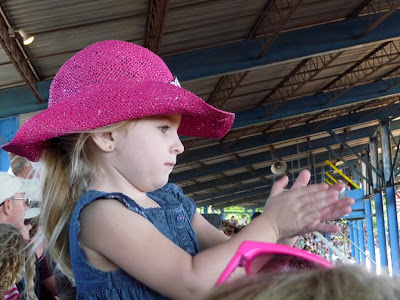Last weekend, I went to the All-Florida Championship Rodeo in Arcadia, which is a cattle town in Central Florida. Attending the event with me was my oldest son, his wife, and daughter. This was to be the first rodeo experience for my granddaughter, Gianna, so I tried to enjoy it through her eyes.
The day was perfect for a rodeo with low humidity and temperature around 25 C. The crowd was comprised mostly of pensioners from retirement communities in the area and local families with school-age children. It began as most American events with a display of patriotism.
We were first treated to bareback riding of the broncos. For my international followers, broncos are horses that have not been 'broken' to carry a rider. As a pilot, we learn of the Flail Response in which a person cannot control his body when experiencing strong acceleration. I surmise that this cowboy was pulling significantly more that 3 G's.
In steer wrestling, the cowboy is to dismount from his horse at full gallop, grab a steer by the horns, and wrestle the beast to the ground. It seems fundamental to accurately match the speed of the cow as it accelerates out of the chute. The wrestler has a wing man who helps him to corral the animal; however, the bovine sprinters were particularly spry and often left the cowboys in their wake.
When the wrangler was actually able to grab the fleeing steer, it was not always a pretty sight, as he dropped the cow to the ground.
The cattle left the spotlight to make way for a little equestrian fanfare. A team of 'horse dancers' performed a precision choreography known as quadrille.
The day was perfect for a rodeo with low humidity and temperature around 25 C. The crowd was comprised mostly of pensioners from retirement communities in the area and local families with school-age children. It began as most American events with a display of patriotism.
We were first treated to bareback riding of the broncos. For my international followers, broncos are horses that have not been 'broken' to carry a rider. As a pilot, we learn of the Flail Response in which a person cannot control his body when experiencing strong acceleration. I surmise that this cowboy was pulling significantly more that 3 G's.
In steer wrestling, the cowboy is to dismount from his horse at full gallop, grab a steer by the horns, and wrestle the beast to the ground. It seems fundamental to accurately match the speed of the cow as it accelerates out of the chute. The wrestler has a wing man who helps him to corral the animal; however, the bovine sprinters were particularly spry and often left the cowboys in their wake.
When the wrangler was actually able to grab the fleeing steer, it was not always a pretty sight, as he dropped the cow to the ground.
In the steer roping event, the pair of cowboys had somewhat better success since they could subdue the fleeing steer with their lariats. In order to be scored for the competition, one rider had to get a lasso around the cow's neck while the other cowhand roped a hind leg.
This technique worked better than just jumping from your mount and grabbing the cows head, albeit it was significantly less bravado. The last roping event involved calves. This seems unduly cruel since it involves scaring the heck out of a baby cow, but it had its own set of requisite skills. Ideally, the calf was to be lassoed in order to bring it to a halt, but this was problematic.
Those wily young cattle were often very fleet of foot. When this bovine ballet made it to completion, the rider rapidly tied the feet of the calf while his clever horse kept the tension on the rope around the calf's neck.
The events were completed with saddled bronco riding and then bull riding. As with most performances, they save the best for last. Bull riding demonstrates that very large performers can be very light on their feet. As soon as these 1400 kilo divos exit the gate, they enter into a whirling dervish with the intention of jettisoning the hapless rider as soon as possible. Few riders managed to stay on the animal's back the required 8 seconds to score points. Often the bulls required distraction by rodeo clowns to keep the angry beasts away from the downed rider.
At dusk, the animals had their favorite time of the whole day as they lined up to be transported back to their paddock for food and an unencumbered run.
Rodeo started in Spain but is popular in North and South America, as well as Australia. The skills that are highlighted are mostly those that traditional cowboys needed to herd and move cattle. Horsemanship is presented in a very practical way that differs from the fine art of equestrian competitions, like ice hockey differs from figure skating. It captures some of the romance of the American West that formed a large part of our history.
Cynics may consider it to be toying with our food, like bull fighting in Spain and Latin America. To get a fresh perspective, I asked my granddaughter what she thought of the proceedings. She said, "Poppi, I don't like the way those men are mean to the cows". Yee Haw, Buckaroo!!










